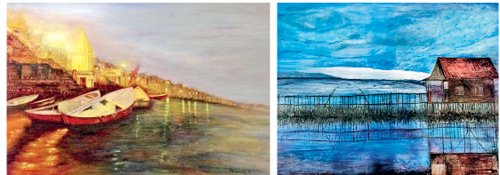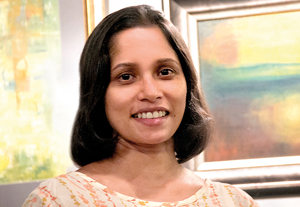Tranquil paintings that will help children with cancer

Light and dark: Two of Nisansala Karunaratne Rajapaksa’s paintings and below, the artist with a cause
The six-month-old baby boy from Monaragala, a cancer patient, has been prescribed a few rounds of chemotherapy by one of the paediatric oncologists at a leading cancer treatment centre. Each round of treatment lasts a few days. He weighs only 4.9 kgs, having lost weight since his diagnosis.
His veins have collapsed. The nurses are desperately trying to find a vein to transfuse the chemo drugs. Even these highly skilled and experienced nurses of the hospital cannot insert the canula needle into a vein. The little one is screaming in pain. After many attempts, he has to be taken into the theatre where the canula will be inserted by a surgical procedure.
A chemotherapy port could have prevented his trauma. A chemotherapy port is a small disk made out of plastic or metal, the size of a coin that can be inserted under the skin of a cancer patient. The port is connected to a vein through a tube and the medicine can be injected into the vein through the port.
 Chemotherapy ports are expensive; not everyone can afford them. Dr. Samadhi Rajapaksa who had witnessed numerous children in pain when a canula is inserted into them for treatment, had decided that something needed to be done. The founder of the Cancer Care Association (CCA) that assists cancer patients with medicine and care through hospitals, hospices and community outreach, Dr. Rajapaksa has initiated the AUBO children’s chemotherapy port project.
Chemotherapy ports are expensive; not everyone can afford them. Dr. Samadhi Rajapaksa who had witnessed numerous children in pain when a canula is inserted into them for treatment, had decided that something needed to be done. The founder of the Cancer Care Association (CCA) that assists cancer patients with medicine and care through hospitals, hospices and community outreach, Dr. Rajapaksa has initiated the AUBO children’s chemotherapy port project.
Through the AUBO project, the CCA has begun donating ports for children with cancer. Each port can mean less trauma for a child, save him from repeated pain, extend his life span or help lead to remission, as it can ensure uninterrupted treatment. The CCA’s current target is to donate two ports every month and it needs a minimum of Rs 120,000 for this.
A child will not need to be pricked and subjected to pain during treatment if he has a chemotherapy port. It would ensure that medicine could be given to him during emergencies, immediately through the port. A port can be kept in the body for the duration it is needed. This can be kept throughout the treatment sessions with proper maintenance.
In resource-rich countries, each cancer patient who is prescribed chemotherapy is assessed and given a port if necessary by the port team. CCA dreams of achieving that facility at least for children with cancer in Sri Lanka.
Artist Nisansala Karunaratne-Rajapaksa, holds a bachelor of fine arts from California State University in the USA, and MA in Buddhist Studies from Kelaniya University. As Dr Rajapaksa’s wife who has been devoted to helping him in the work of the CCA, she will donate all the money from the sale of her paintings to the ĀAUBO project.
“The ĀAUBO project is about trying to save a life,” says Nisansala. “As an artist I want to create works of art that will give peace and tranquility to people. People’s lives are full of stress and harassment and I don’t want to add to that. And I felt that a fundraiser for the AUBO project through my paintings will complement the objectives of both,” she adds.
Nisansala leafs through a folio of her paintings as she speaks. Her “Ganga” reminds me of a Turner painting: She explains, “I painted this after a boat ride on Ganges in Varanasi early in the morning, even before dawn. We watched the lights of a Hindu temple light up the river banks as people bathed, washed their clothes and floated out bodies that were being cremated.”
A moored empty boat lies on the foreground of the painting, dragged on to the steps on the river bank, by a boatman yet to arrive. It first directs us towards the brilliant lighting of the temple and then towards the dark, far distance of the river.
In the painting titled “Inle Lake”, Nisansala takes us once again on a boat journey in Inle Lake in Myanmar before dawn. The stillness of the lake is palpable and the angle of the viewer’s vision of the lake, draws the eye forward, through the still water, just as if we too were on the boat, gliding towards the passenger’s destination. In both paintings, Nisansala shows a mastery at balancing realism and impressionism to produce a painting that is neither.
In complete contrast, “Rata” and “Arise” are abstract and stylized renditions of patterns and the impact of the sun. “Arise was inspired by a visit to Wilpattu,” says Nisansala, “it shows the sun not as a real object but as a surreal source of light shining over the forest below. I normally paint in my studio, so I paint from memory and the feeling that I brought away from that moment.” In “Untitled” rectangles of colour in different, complexly shaded tones surround a gray-white space with an unblemished centre.
While Nisansala is an artist and also the founder of Casa Serena, the gallery that exhibited paintings of local and international artists, her day is consumed by her work at the CCA. Founded by Nisansala’s husband, Dr. Samadhi Rajapaksa in 2003 with the support of Consultant Clinical Oncologist Dr.Upul Ekanayake as a small organization in the Anuradhapura district, the CCA now has a range of projects that aim to help cancer patients supporting their financial, social and spiritual needs, working closely with the government cancer hospitals in Maharagama, Anuradhapura and Karapitiya.
The CCA also runs a hospice in Anuradhapura and will be opening another in Matara. Its projects include a daily free lunch project for patients and carers who attend the clinics at the Maharagama hospital. There is a free medication project, breast prosthesis project, financial aids, “Pibidena Kekulu” scholarship project, and “a donate Rs. 5 per day” project.
The CCA’s homebased palliative care project deploys a group of dedicated staff who visit homes of families that wish to keep loved ones in the terminal stages of cancer without sending them to a hospice. The staff guide the family members on nursing care techniques, assist them with their financial needs and provide medicine, especially for pain management, and in many cases support the family through their period of grieving when their loved one dies.
“From the time I met my husband I have been helping him,” Nisansala says. “I make sure that when a donor gives money for a particular project that we use it only for that project. We are trying not to make this association heavy on administration costs. Because that means the funds that we get for patients will be wasted. So we try to do as much as we can ourselves and through volunteers or really dedicated staff.
Nisansala says, “For example, the lady who cooks the food for the free meal per day project has experienced the burden of cancer. She is completely dedicated to what she does. She buys the ingredients, cooks the food, takes it to the hospital, serves it and then brings the utensils back every day. We pay her a nominal stipend, but we know that her dedication to the project cannot be measured.”
Going back to her work, Nisansala mentions that her work is held in collections outside Sri Lanka, including that of the Padmanabadasa Uttarananda Maratanda Varma Maharaja of Travancore. “If I sell all the paintings, we will have enough funds for chemotherapy ports for at least 24 children with cancer,” she smiles.
Nisansala’s exhibition will be on at the Lionel Wendt, on June 2 and 3.
To donate to the CCA’s projects visit: https://cancercaresl.com/
(Ramya Chamalie Jirasinghe is a poet and Deputy Director of the US-Sri Lanka Fulbright Commission)


